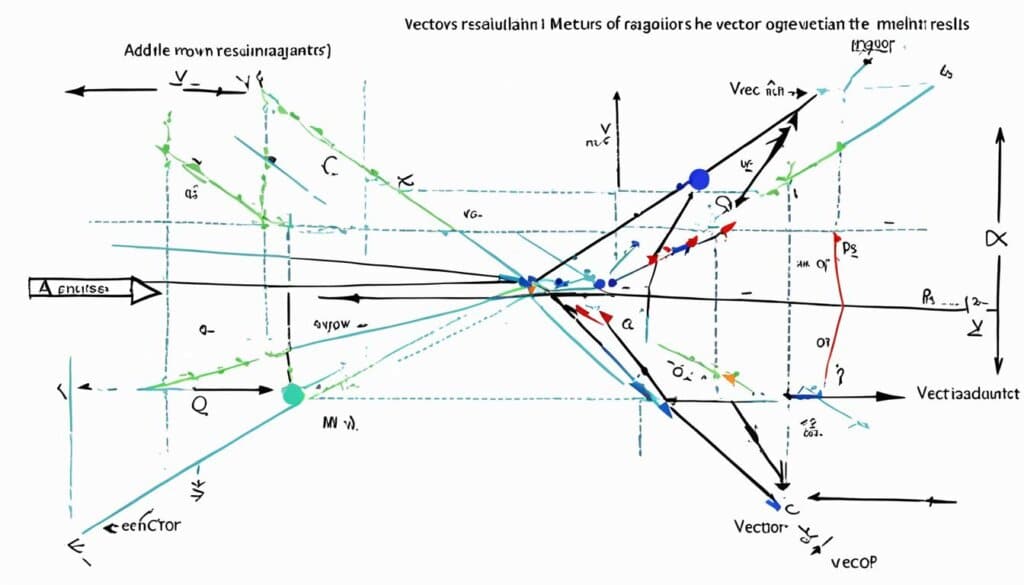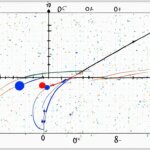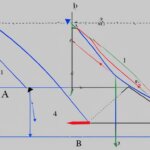Table of Contents
A vector is a fundamental concept in mathematics that combines both magnitude and direction. In the world of mathematics, vectors are used to represent quantities like force and velocity, where both magnitude and direction play crucial roles. It is denoted using boldface or arrow notation. The magnitude of a vector is represented by double bars around the vector symbol, emphasizing its size or length.
Imagine a line segment with an arrow indicating a specific direction. This directed line segment represents a vector. The length of the segment represents the magnitude of the vector, while the arrow indicates the direction. It is important to note that the zero vector is the only vector without a specified direction.
When it comes to operations on vectors, various actions can be performed, including addition, subtraction, and multiplication by a scalar. Addition allows the combination of vectors, visualized by joining them head-to-tail. Subtraction involves reversing the direction of the vector to be subtracted and then adding it. Scalar multiplication scales the magnitude of a vector without changing its direction.
Understanding vectors is essential for solving mathematical problems and analyzing physical phenomena. Vectors are a powerful tool with applications in several fields, such as physics, engineering, and computer graphics. By comprehending the concept of vectors and their properties, you can further explore the fascinating world of mathematics with confidence and accuracy.
Definition of a Vector
A vector is an object that possesses both magnitude and direction. Geometrically, it can be represented as a directed line segment, with the length indicating the magnitude and the arrow indicating the direction.
Vectors such as force and velocity demonstrate both magnitude and direction. The magnitude of a vector represents the strength of the force or the speed associated with the velocity.
Vectors are denoted using boldface or arrow notation, emphasizing their significance. The magnitude of a vector is visually represented by double bars enclosing the vector symbol.
“Vectors are mathematical entities that convey information about both the size and the direction of a physical quantity. They play a crucial role in various scientific and engineering applications, enabling us to describe and analyze complex systems with precision and accuracy.”
Operations on Vectors
Various operations can be performed on vectors to manipulate and analyze their properties. These operations include addition, subtraction, and scalar multiplication. Let’s explore each operation in detail.
Addition of Vectors
Vector addition involves combining multiple vectors to obtain their sum. To add vectors, we join them head-to-tail (also known as the “parallelogram method”). The resultant vector is the vector that connects the initial point of the first vector to the terminal point of the last vector.
For example, consider two vectors, A and B. The vectors are added by placing the initial point of B at the terminal point of A. The resultant vector, denoted as A + B, connects the initial point of A to the terminal point of B.
This process can be visualized geometrically without reference to any coordinate system. The sum of vectors signifies the combination of forces or velocities in scenarios such as determining the total velocity of an object moving in different directions.
Subtraction of Vectors
Vector subtraction is used to calculate the difference between two vectors. To subtract a vector, we reverse the direction of the vector to be subtracted and then add it to the other vector using vector addition.
For instance, let’s consider two vectors, C and D. To find the difference C – D, we reverse the direction of D and add it to C using vector addition. The resultant vector connects the initial point of C to the terminal point of -D.
Vector subtraction allows us to determine the net force or velocity in a given situation by identifying the resultant vector that represents the difference between the two vectors.
Scalar Multiplication of Vectors
Scalar multiplication involves scaling the magnitude of a vector without changing its direction. This operation is performed by multiplying the vector by a scalar, which is a real number. If the scalar is positive, the vector is stretched or compressed in the same direction. If the scalar is negative, the vector is stretched or compressed in the opposite direction after reversing its direction.
For example, consider a vector E and a scalar s. Scalar multiplication is represented as sE. If s is positive, the magnitude of E increases in the same direction. If s is negative, the magnitude of E increases in the opposite direction.
The resulting vector’s magnitude is calculated by taking the absolute value of the scalar multiplied by the magnitude of the original vector. Scalar multiplication is useful for scaling vector quantities, such as adjusting the intensity of a force or changing the speed of an object’s velocity.
To summarize, operations on vectors, including addition, subtraction, and scalar multiplication, allow us to manipulate vectors to analyze different aspects of their magnitude and direction. These operations can be performed geometrically and have practical applications in various fields, including physics, engineering, and mathematics.
| Operation | Example | Result |
|---|---|---|
| Addition (A + B) |  |
The resultant vector connecting the initial point of A to the terminal point of B |
| Subtraction (C – D) | The resultant vector connecting the initial point of C to the terminal point of -D | |
| Scalar Multiplication (sE) | s = 2 | The vector E stretched in the same direction by a factor of 2 |
Properties of Vector Addition
Vector addition is a fundamental operation in mathematics that possesses two important properties: the commutative law and the associative law. These properties make vector addition both well-defined and consistent, providing a solid foundation for efficient and accurate calculations.
The commutative law: The commutative law of vector addition states that the order of adding vectors does not affect the result. In other words, the sum of two vectors remains the same regardless of the order in which they are added. This property can also be referred to as the parallelogram law, as it can be visually illustrated using a parallelogram construction.
“The commutative law ensures that the sum of two vectors is independent of their order.”
The associative law: The associative law of vector addition states that the sum of three vectors remains the same, regardless of the order in which the addition is performed. This means that when adding three vectors together, the grouping of the vectors does not affect the final result.
“The associative law guarantees that the sum of three vectors is consistent, regardless of the order of addition.”
These properties of vector addition provide a solid basis for performing calculations involving vectors. They simplify the process of combining forces and velocities, allowing for accurate analysis and solution of problems in various fields, including physics, engineering, and mathematics.
Illustration of the Commutative Law
To visually demonstrate the commutative law, consider the following example:
In the image above, we have two vectors, represented by directed line segments AB and AC. By applying the commutative law, we can see that the sum of vector AB followed by vector AC (resulting in vector AD) is equal to the sum of vector AC followed by vector AB (resulting in vector AE).
By obeying the properties of vector addition, we can perform calculations efficiently and accurately, leading to a deeper understanding of vector operations and their applications in various domains.
Vector Subtraction and Scalar Multiplication
Vector subtraction involves adding the opposite vector, which has the same magnitude but opposite direction. To perform this operation, we reverse the direction of the vector to be subtracted and then add it to the other vector using vector addition.
On the other hand, scalar multiplication of a vector allows us to scale its magnitude without changing its direction. If the scalar value is positive, the vector is stretched or compressed in the same direction. Conversely, if the scalar is negative, the vector is stretched or compressed in the opposite direction after reversing its direction.
The resulting vector’s magnitude is determined by taking the absolute value of the scalar and multiplying it by the magnitude of the original vector.
To better understand vector subtraction and scalar multiplication, let’s take a look at a practical example:
Consider a vector representing the displacement of a car from its starting point. If we subtract the opposite vector, we can find the reverse displacement back to the starting point. Scalar multiplication of this vector can either stretch the displacement or compress it, depending on the scalar value.
By visually representing vector subtraction and scalar multiplication, we can gain a clearer understanding of these operations and how they affect the stretch and direction of vectors.
Now that we have explored vector subtraction and scalar multiplication, we can move on to understanding the magnitude and direction of vectors in the next section.
Magnitude and Direction of a Vector
In mathematics, the magnitude and direction of a vector are essential properties that provide valuable information about the vector’s characteristics. Let’s explore how these properties are represented and calculated in different coordinate systems.
Magnitude of a Vector
The magnitude of a vector represents its size or length. It is calculated using the Pythagorean theorem, which involves taking the square root of the sum of the squares of the vector’s components in a coordinate system. For example, in a two-dimensional Cartesian coordinate system, a vector with components (x, y) has a magnitude given by:
|v| = √(x^2 + y^2)
Similarly, in a three-dimensional Cartesian coordinate system, a vector with components (x, y, z) has a magnitude given by:
|v| = √(x^2 + y^2 + z^2)
The magnitude of a vector is always a positive value.
Direction of a Vector
The direction of a vector indicates the angle it makes with a reference axis. Vectors can be represented in different coordinate systems, such as Cartesian or polar coordinates.
In Cartesian coordinates, a vector is represented by its x and y components. The direction can be calculated using trigonometric functions like arctan or atan2. For example, the angle θ that a vector (x, y) makes with the positive x-axis is given by:
θ = atan2(y, x)
In polar coordinates, a vector is represented by its magnitude (r) and angle (θ). The angle represents the direction of the vector with respect to the reference axis. Converting between Cartesian and polar coordinates involves using trigonometric functions like cosine and sine.
Representing Vectors in Different Coordinate Systems
Vectors can be represented in different coordinate systems to facilitate their analysis and calculations. In Cartesian coordinates, a vector is represented by its components along the x and y axes. In polar coordinates, a vector is represented by its magnitude and angle. Other coordinate systems, such as cylindrical or spherical coordinates, can also be used for specific applications.
Here’s a comparison of vector representations in Cartesian and polar coordinates:
| Coordinate System | Representation of a Vector |
|---|---|
| Cartesian Coordinates | (x, y) |
| Polar Coordinates | (r, θ) |
The choice of coordinate system depends on the specific problem and the ease of calculations required.
The magnitude and direction of a vector play a crucial role in vector analysis and problem-solving. They allow us to understand the size and orientation of vectors and apply mathematical operations to solve complex problems in various fields, including physics, engineering, and computer science.
Vectors in Multiple Dimensions
Vectors are not limited to two dimensions; they can be extended to multiple dimensions beyond the usual Cartesian coordinate system. In three dimensions, vectors have three components corresponding to the x, y, and z axes. Vectors in higher dimensions follow the same principles, with each dimension represented by a component.
The magnitude and direction of vectors in multiple dimensions can be calculated using the same principles as in two dimensions. Cartesian coordinates can be used to represent vectors in multiple dimensions by specifying the values of each component. Polar coordinates can also be used, with the magnitude determined by the distance from the origin and the direction indicated by the angle of rotation.
Vectors in multiple dimensions find applications in various fields of mathematics, physics, and engineering. They are used to represent quantities and analyze complex systems that cannot be adequately described in two dimensions. Understanding vectors in multiple dimensions is essential for solving real-world problems and advancing scientific and technological advancements.
FAQ
What is a vector in mathematics?
A vector is an object in mathematics that has both magnitude and direction. It can be represented as a directed line segment, with the length of the segment indicating the magnitude of the vector and the arrow indicating the direction.
How can vectors be used to represent quantities?
Vectors are commonly used to represent quantities like force and velocity, where both magnitude and direction are important. The magnitude of a vector represents the strength of the force or the speed associated with the velocity.
How are vectors denoted?
Vectors are denoted using boldface or arrow notation. The magnitude of a vector is represented by double bars around the vector symbol.
What operations can be performed on vectors?
Operations on vectors include addition, subtraction, and multiplication by a scalar.
How is vector addition visualized?
Addition of vectors can be visualized by joining the vectors head-to-tail.
How is vector subtraction performed?
Vector subtraction is performed by adding the opposite vector, which is the vector with the same magnitude but opposite direction.
What is scalar multiplication of a vector?
Scalar multiplication of a vector scales its magnitude without changing its direction.
What are the properties of vector addition?
Vector addition satisfies the commutative law (the order of addition doesn’t matter) and the associative law (the sum of three vectors does not depend on the order of addition).
How is the magnitude of a vector calculated?
The magnitude of a vector can be calculated using the Pythagorean theorem, which involves taking the square root of the sum of the squares of the vector’s components in a coordinate system.
How can vectors be represented in different coordinate systems?
Vectors can be represented in different coordinate systems, such as Cartesian or polar coordinates. In Cartesian coordinates, a vector is represented by its x and y components, while in polar coordinates, a vector is represented by its magnitude and angle.
How are vectors extended to multiple dimensions?
Vectors can be extended to multiple dimensions by adding components corresponding to each dimension. In three dimensions, vectors have three components corresponding to the x, y, and z axes.
In what fields are vectors in multiple dimensions used?
Vectors in multiple dimensions are used in various fields of mathematics, physics, and engineering to represent quantities and analyze complex systems.












